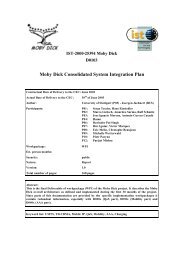COMNET III CACI
COMNET III CACI
COMNET III CACI
You also want an ePaper? Increase the reach of your titles
YUMPU automatically turns print PDFs into web optimized ePapers that Google loves.
3.2.3 Other Protocols over ATM<br />
The above discussion assumes that the end-systems are equipped with ATM modules.<br />
However, in many cases, you may want to model higher layer protocols which make use<br />
of an ATM backbone. This scenario can be modeled in <strong>COMNET</strong> <strong>III</strong> using the<br />
transit network building block. This building block would represent the ATM<br />
backbone, to which the other LANs or WANs are connected. Instead of specifying the<br />
ATM transport protocol parameters at a traffic source, you would specify them<br />
at the transit network details. The source would take on the parameter set of the<br />
higher layer protocols, such as TCP/IP, and thus generate traffic corresponding to this<br />
protocol. When the packets are reaching the transit network, they are segmented<br />
to the transit network’s ATM transport protocol and re-assembled to the<br />
higher layer PDU upon leaving the transit network. All the principles about<br />
modeling ATM outlined above now simply have to be applied to the transit<br />
network.<br />
Transit networks in <strong>COMNET</strong> <strong>III</strong> introduce an additional level of flexibility. They<br />
contain the concept of service classes and connection types. The incoming<br />
traffic has a service class requirements measured as an integer. The transit<br />
network has a list of service classes dividing the integer range into non-overlapping<br />
bins. This implies that each incoming packet is mapped onto a single service class. The<br />
association with a service class then determines the destinations to which the packet can<br />
be transmitted (and hence which types of links that are available to the packet inside the<br />
network through the transit network routing algorithm). Furthermore, it<br />
determines what protocol is used inside the transit network. These concepts allow<br />
a classification of the traffic and a mapping onto different link speeds and protocol<br />
functions. In case you do not need to make such a distinction, simply enter a single<br />
service class and a single connection type with its respective ATM transport<br />
protocol.<br />
17
















